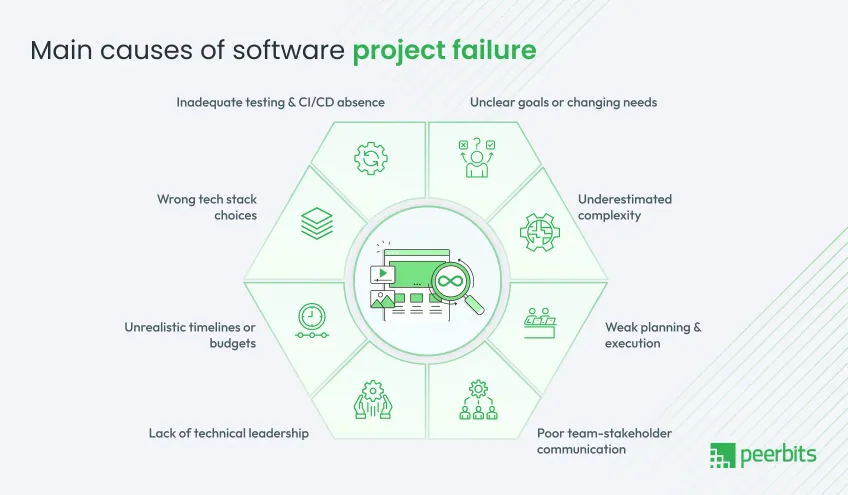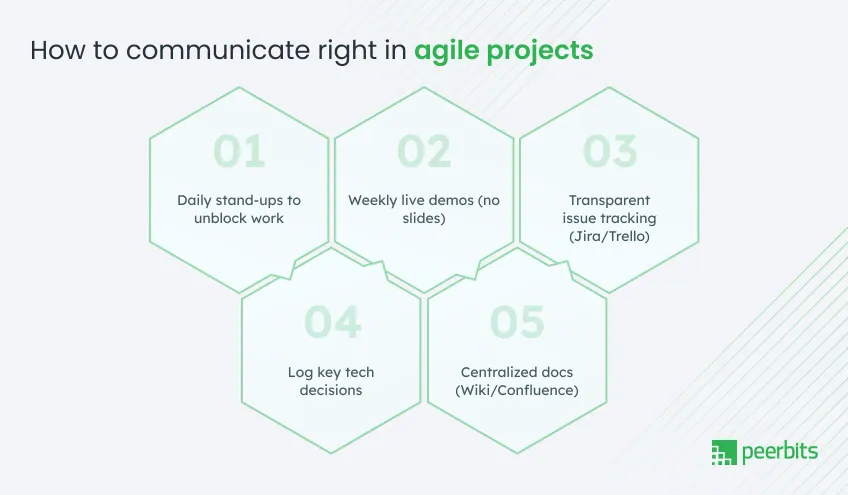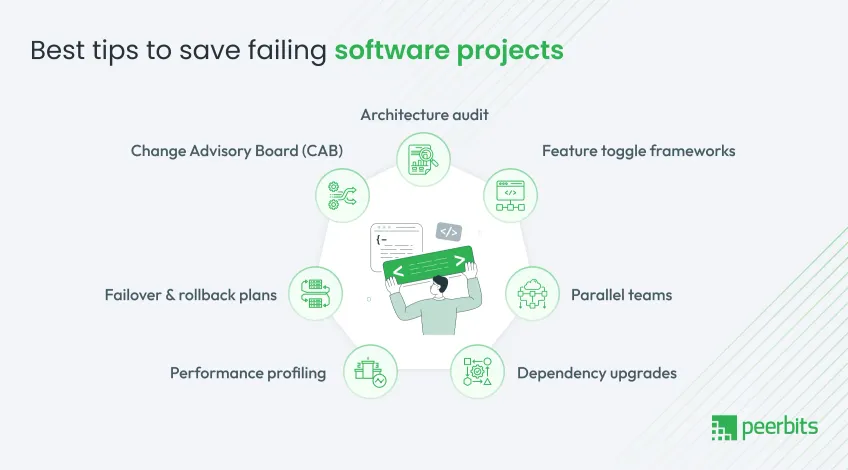Projects don��’t fail overnight. They slip, stall, and silently spiral into chaos. Deadlines turn into moving targets. Costs start ballooning. Quality drops. Teams burn out. And the worst? Everyone starts pointing fingers instead of solving problems.
The percentage of software project fail is quite high. Based on a report, 70% of project failures occur during digital transformation. The main consequences of these failures are extremely severe, ranging from financial losses and reputational damage to missed opportunities and lost competitive advantage.
If you’ve found yourself here, there’s a good chance your software project is stuck or worse- failing. Before things spiral, it’s time to hire software developers who can rescue the roadmap. But for that too, first you should figure out what's going wrong!
The good news? A failing software development project isn’t always doomed. It can be rescued. Whether you’re managing an in-house team or working with an offshore vendor, you can stop the hustle, regain control, and still deliver value.
Let’s get straight to the saving. Here’s a step-by-step guide on how to save or rescue a failing software development project in detail, including battle-tested techniques & real-world examples.
Step 1: Stop and assess first
The first instinct in most cases software development services encounter is to fix something fast. Add more developers. Rewrite modules. Change tools. But before anything else: Pause.
Why? Because you can’t fix what you don’t understand. Many failing projects rush into rescue mode without knowing what’s actually broken.
Here’s what to do first to rescue software project:
-
Review scope vs. reality: Compare original requirements to current deliverables. Where did things fall behind?
-
Check milestones: What was promised and what’s actually done so far, and most importantly, what’s missing?
-
Evaluate code health: Run static code analysis, manual reviews, and quality metrics (test coverage, cyclomatic complexity, code smells).
-
Audit team velocity: Look at burndown charts, sprint velocity trends, and how estimates compare to actuals that were promised to the client.
-
Revisit budget: Identify where and why costs overshot, scope creep, overtime, and rework. And mark it down firmly.
-
Talk to stakeholders: Keeping all the odds & egoes aside, try to understand frustrations, expectations, and hidden requirements.
This deep dive often reveals the real cause of failure in software project management, including unclear requirements, underestimated complexity, misaligned teams, or overpromised timelines.
Step 2: Identify the root causes

Symptoms fool many managers: missed deadlines, buggy releases, and low morale. But those aren’t causes, they are consequences. You have to find the main causes of project failure with an unbiased approach.
Major reasons for software project failure usually involve:
- Unclear or shifting requirements
- Underestimated complexity
- Software implementations fail
- Poor communication between stakeholders and dev team
- Lack of skilled leadership or technical guidance
- Over-pitched timelines or budgets
- Wrong choice of tech stack or architecture
- Low test coverage or absent CI/CD
Document each reason for software project failure in plain language. Use tools like fishbone diagrams or 5 Whys analysis. It helps you keep the discussion objective, avoids blame, and focuses on software development solutions.
Step 3: Reset Expectations
One hard truth that many managers have a hard time doing so is this. For software development project rescue, it is apparent that you have to change the scope, timeline, or budget. Trying to “just work harder” rarely works at this stage.
For this, communicate openly:
-
Share assessment findings with stakeholders.
-
Explain why software projects fail and what it’ll take to recover.
-
Offer clear options: reduce scope, extend deadlines, or add budget.
-
Discuss the impact of each option on delivery and quality.
Transparency has higher chances of rebuilding trust; hiding figures can cause bigger problems to appear later on, where it's even harder to go back.
Step 4: Stabilise the current build
Surely, new add-ons are necessary to save your failing software development in major cases. But before thinking about new features, make sure you are able to stop the bleeding and save yourself from software implementation fail. For that:
-
Freeze new feature development temporarily.
-
Fix blocking bugs that crash systems or corrupt data.
-
Improve test coverage to catch regressions.
-
Refactor the most critical and fragile modules.
If the product is in production, stabilising it also protects current users and prevents further damage, avoiding failure in software project management.
Some of the best tips to rescue software project and its destabilized state include:
Automated testing: Unit tests, integration tests, regression suites.
CI/CD pipelines: Catch issues earlier, release fixes faster.
Feature toggles: Disable half-finished or unstable features.
Step 5: Rebuild the Roadmap
Once stabilised, your experts can create a new delivery plan considering all the setbacks that were assessed as issues previously:
-
Re-estimate remaining work with real data, not optimism.
-
Break the work into smaller, clearly defined deliverables.
-
Prioritise features that deliver the highest business value.
-
Use agile approaches (Scrum, Kanban) to deliver incrementally.
Make sure every estimate is peer-reviewed, also include buffers, even good teams hit unexpected snags, so make sure you are ready for this in advance.

Step 6: Strengthen the team
Many software-failing projects suffer because teams are either stretched too thin or lack critical expertise. To recover from that, you can:
-
Bring in experienced software architects or senior engineers to review the design and code.
-
Add QA automation engineers to speed up testing.
-
Replace or retrain team members who struggle with core technologies.
-
Reassign clear ownership of modules and deliverables.
Sometimes, the fresh perspective of an external consultant helps spot blind spots that internal teams miss. Though you can consider your initial budgets before overspending on consultants or hiring offshore software dev teams.
Step 7: Improve communication

Poor communication is a common silent killer in many software development companies. Rescue efforts succeed when your teams can talk openly, early, and often. To promote this you can practise:
- Daily stand-ups to share blockers.
- Weekly demos to stakeholders (show working software, not slides).
- Use issue tracking tools (Jira, Trello) transparently.
- Document technical decisions and design trade-offs.
- Keep a single source of truth (project wiki, Confluence).
Good communication reduces surprises, and surprises derail projects.
Step 8: Cut scope, but do it smartly
It’s tempting to keep everything in scope and just “work harder.” But that rarely ends well. Instead, it's better to plan for the worst and keep it as a priority:
- Use frameworks like MoSCoW (Must have, Should have, Could have, Won’t have).
- Focus first on features tied directly to business goals or compliance.
- Defer or drop features that add polish but no core value.
Stakeholders may resist if you pitch such an approach, but it's better to plan in advance regarding this on the sidelines. Show them trade-offs in terms of timeline, cost, and risk, then practise this method.
Step 9: Address technical debt
Many failing projects carry crippling technical debt that usually starts with messy code, outdated dependencies, and poor documentation. You can’t fix everything at once. But you must fix what blocks progress:
- Refactor code that frequently breaks.
- Replace unsupported libraries.
- Document critical modules.
- Add missing automated tests.
Prioritise debt that hurts team velocity or product stability, and keep track of the new approaches with much more care to
Step 10: Strengthen delivery with metrics
Any rescue of software project in 2025 can’t be complete without tracking the metrics. Guessing progress leads to nasty surprises. Instead, track measurable indicators for better understanding:
- Sprint velocity and throughput.
- Bug count and severity trends.
- Code coverage percentages.
- Deployment frequency and lead time.
- Rollback or hotfix counts.
Share metrics with the team and stakeholders. Numbers spark objective discussions rather than just talking in mere approximations to avoid failure in software project management.
Read more: Key challenges in custom software development & their fixes
Step 11: Plan for controlled recovery
Recovery isn’t about working nights and weekends indefinitely. Burnt-out teams write buggy code. Instead, to achieve a more stable and creative build:
- Set a sustainable pace (e.g., max 40–45 hours/week).
- Automate repetitive tasks (testing, deployment).
- Use rolling releases: deliver small increments instead of big-bang launches.
- Create “hard stops” for scope changes each sprint.
Projects recover best when teams stay healthy and focused.
Step 12: Prepare for future failures
Once the project stabilises, take steps to avoid repeating mistakes. Asking how to save a failing software in 2025 can be a one-way recovery; not every chance can be converted into a success. Therefore, focus on:
- Retrospectives: What went wrong, why, and how to prevent it.
- Documentation: Write down lessons learned, design decisions, and process changes.
- Standardise processes: code reviews, CI/CD, automated testing.
- Continuous learning: training on new tools, frameworks, or patterns.
Even successful software development projects can slide back into trouble. Build resilience by institutionalising good practices.
Advanced tips for saving complex software projects

Surely, the above steps are crucial for software development project rescue. But beyond the basics, here are expert-level tips to rescue for failing software development project that save deeply troubled projects:
-
Architecture audit: Re-evaluate if the current architecture fits new requirements or load. Sometimes microservices help, sometimes they hurt.
-
Feature toggle frameworks: Like LaunchDarkly, allow gradual rollouts, A/B testing, and safe rollbacks.
-
Parallel teams: One team stabilises production, and another develops new features.
-
Dependency upgrades: Modernise outdated packages to avoid security risks and incompatibility.
-
Performance profiling: Find slow database queries, memory leaks, and network bottlenecks that frustrate users.
-
Failover & rollback plans: Especially for enterprise apps, to prevent outages during releases.
-
Change Advisory Board (CAB): For projects under strict compliance or with many integrations.
Real-world failed software project case studies
Here are a few software project failures examples that highlight how even the biggest brands can suffer from poor software decisions. They also prove technical choices, stakeholder alignment, testing rigor, and localized context matter immensely.
1. Boeing 737 MAX

Issue: The MCAS software had flawed logic and inadequate sensor redundancy. It didn’t properly account for pilot behavior during malfunctions.
Consequence: 346 lives lost, global fleet grounding, $27B+ in losses, massive trust and reputation damage.
How it happened: Poor software design, insufficient simulation-based testing, and lack of pilot training led to system-triggered crashes.
Recovery: Boeing revamped software testing, pilot training protocols, and underwent intense regulatory scrutiny to return the MAX to service.
2. IBM Watson for Oncology

Issue: The AI made inaccurate or unsafe cancer treatment recommendations; it struggled to adapt to regional guidelines and lacked contextual understanding.
Consequence: Billions lost in investments, failed partnerships, and public criticism. IBM shut down Watson Health in 2023.
How it happened: Trained with limited data and U.S.-centric protocols; struggled with real-world medical variability and inconsistent global practices.
Recovery: IBM exited the healthcare AI vertical, selling off Watson Health assets; shifted focus to enterprise AI and cloud infrastructure.
3. Nike & i2 supply chain software failure

Issue: Flawed demand prediction by i2 software led to massive inventory mismanagement and order errors.
Consequence: $100M in lost sales, 20% stock dip, and public backlash. i2 and Nike blamed each other.
How it happened: Rushed rollout, unrealistic timelines, and lack of integration planning caused operational disruptions.
Recovery: Nike restructured its entire supply chain strategy, invested in a full ERP overhaul with SAP, and gradually achieved long-term efficiency. Despite early damage, its market dominance helped it bounce back.
Conclusion
Rescuing a failing software development project isn’t easy, but it is possible. The worst thing you can do is keep going blindly, hoping things magically improve. So, as we’ve understood, make sure to:
- Pause and assess.
- Find and fix root causes.
- Reset expectations and rebuild trust.
- Stabilise first, then deliver value incrementally.
- Communicate openly and measure everything.
Projects don’t fail because of bad code alone. They fail because problems stay hidden, teams stop talking, and recovery starts too late. If your project shows signs of failure, act now. The sooner you act, the more you can recover.

FAQs
Signs include slipping deadlines, increasing bug counts, team burnout, scope creep, and stakeholder dissatisfaction.
Be transparent early. Share honest assessments, but come prepared with mitigation options.
Yes. If caught early, projects can be stabilized, realigned, and delivered through structured recovery processes and communication resets.
Pause and assess the situation. Review scope, budget, progress, code quality, and stakeholder alignment before taking any action.
Scope creep is a recurring blocker. Keep a documented change trail, and negotiate each change based on its impact on schedule or budget.
Poor onboarding amplifies delays. Missing setup steps, outdated docs, and manual configs waste valuable time.
Not always. Often, the issue lies in leadership, planning, or requirements, not the team. Evaluate skills gaps and communication breakdowns first.
It depends. If the architecture is fundamentally broken or misaligned, rebuilding may be cheaper long-term. Otherwise, stabilizing and refactoring might suffice.








